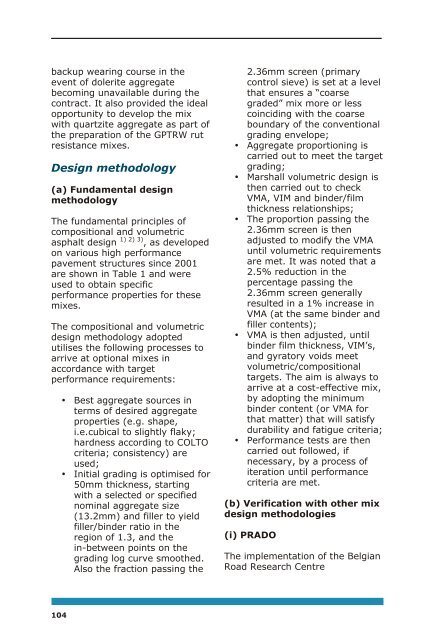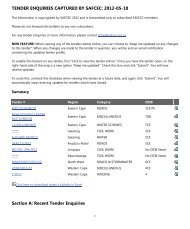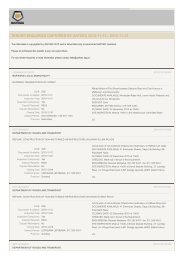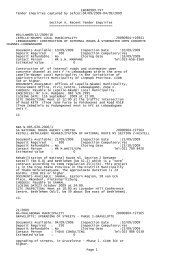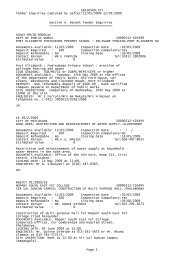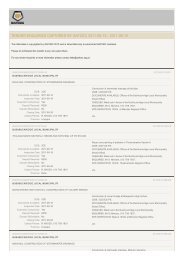DIGEST 2006 - Sabita
DIGEST 2006 - Sabita
DIGEST 2006 - Sabita
You also want an ePaper? Increase the reach of your titles
YUMPU automatically turns print PDFs into web optimized ePapers that Google loves.
ackup wearing course in the<br />
event of dolerite aggregate<br />
becoming unavailable during the<br />
contract. It also provided the ideal<br />
opportunity to develop the mix<br />
with quartzite aggregate as part of<br />
the preparation of the GPTRW rut<br />
resistance mixes.<br />
Design methodology<br />
(a) Fundamental design<br />
methodology<br />
The fundamental principles of<br />
compositional and volumetric<br />
asphalt design 1) 2) 3) , as developed<br />
on various high performance<br />
pavement structures since 2001<br />
are shown in Table 1 and were<br />
used to obtain specific<br />
performance properties for these<br />
mixes.<br />
The compositional and volumetric<br />
design methodology adopted<br />
utilises the following processes to<br />
arrive at optional mixes in<br />
accordance with target<br />
performance requirements:<br />
• Best aggregate sources in<br />
terms of desired aggregate<br />
properties (e.g. shape,<br />
i.e.cubical to slightly flaky;<br />
hardness according to COLTO<br />
criteria; consistency) are<br />
used;<br />
• Initial grading is optimised for<br />
50mm thickness, starting<br />
with a selected or specified<br />
nominal aggregate size<br />
(13.2mm) and filler to yield<br />
filler/binder ratio in the<br />
region of 1.3, and the<br />
in-between points on the<br />
grading log curve smoothed.<br />
Also the fraction passing the<br />
2.36mm screen (primary<br />
control sieve) is set at a level<br />
that ensures a “coarse<br />
graded” mix more or less<br />
coinciding with the coarse<br />
boundary of the conventional<br />
grading envelope;<br />
• Aggregate proportioning is<br />
carried out to meet the target<br />
grading;<br />
• Marshall volumetric design is<br />
then carried out to check<br />
VMA, VIM and binder/film<br />
thickness relationships;<br />
• The proportion passing the<br />
2.36mm screen is then<br />
adjusted to modify the VMA<br />
until volumetric requirements<br />
are met. It was noted that a<br />
2.5% reduction in the<br />
percentage passing the<br />
2.36mm screen generally<br />
resulted in a 1% increase in<br />
VMA (at the same binder and<br />
filler contents);<br />
• VMA is then adjusted, until<br />
binder film thickness, VIM’s,<br />
and gyratory voids meet<br />
volumetric/compositional<br />
targets. The aim is always to<br />
arrive at a cost-effective mix,<br />
by adopting the minimum<br />
binder content (or VMA for<br />
that matter) that will satisfy<br />
durability and fatigue criteria;<br />
• Performance tests are then<br />
carried out followed, if<br />
necessary, by a process of<br />
iteration until performance<br />
criteria are met.<br />
(b) Verification with other mix<br />
design methodologies<br />
(i) PRADO<br />
The implementation of the Belgian<br />
Road Research Centre<br />
104


